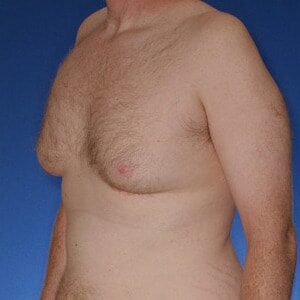It’s important to define what the ideal male chest looks like before explaining what the various types of gynecomastia look like, so it is clear what can be accomplished through male breast reduction surgery. Patients must understand not every man can have the “ideal” chest. Various conditions such as aging, excess body weight, poor skin quality, and unfavorable anatomy affect what is obtainable.


Ideal Chest Images: Notice the horizontal orientation of breast tissue, which acts as an outline of the underlying “pec” muscle.
As you can see from the pictures, the “ideal” chest is not flat. There is a defined contour and natural fold just below the chest where the abdomen begins. The chest fold is predominately horizontal. This horizontal line tends to round out and increases with the varying degrees of gynecomastia.
On the “ideal” chest, the nipple is typically 5-6 cm above the chest fold and faces forward. The areola is flush with the surrounding skin. With certain types of gynecomastia, the areola will protrude forward creating what is called “puffy nipple.”

Ideal Chest (Profile view) – The ideal chest is not flat and has a defined masculine contour.
If you look at the cut-out above, you will notice approximately ½ inch of fat underneath even this “idea” chest. Since this is a natural part of the chest, it is not wise to completely remove all of the fat during surgery. Lastly, take a look at the contour of the pectorals major muscle in relation to the chest fold.

Ideal Chest – Above cut-out view demonstrates what is considered normal fat under the skin and underlying pectorals major muscle
The “ideal” male chest has some breast tissue located directly below the areola. You can feel it by squeezing the tissue under the areola. It is firm, glandular tissue, where fatty tissue is soft and squishy. This amount of breast tissue shown is considered to be normal. Gynecomastia is an excess of this normal breast tissue.

Ideal Chest – Above slice view demonstrates that even the ideal chest has breast tissue underneath the nipple







